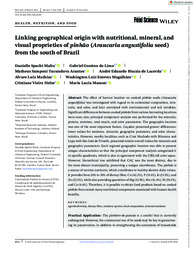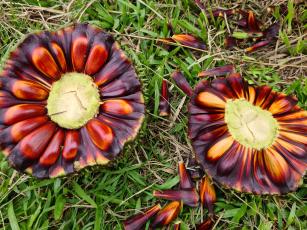Linking geographical origin with nutritional, mineral, and visual proprieties of pinhão (Araucaria angustifolia seed) from the south of Brazil.
Linking geographical origin with nutritional, mineral, and visual proprieties of pinhão (Araucaria angustifolia seed) from the south of Brazil.
Author(s): MALTA, D. S.; LIMA, G. G. de; ARANTES, M. S. T.; LACERDA, A. E. B. de; MATHIAS, A. L.; MAGALHAES, W. L. E.; HELM, C. V.; MASSON, M. L.
Summary: The effect of harvest location on cooked pinhão seeds (Araucaria angustifolia) was investigated with regard to its centesimal composition, minerals, and color, and later correlated with environmental and soil variables. Significant differences between cooked pinhão from various harvesting locations were seen; also, principal component analysis was performed for the minerals, protein, moisture, total starch, and color parameters. The geographic location was one of the most important factors. Caçador presented greater differences: lower values for moisture, minerals, geographic parameter, and color characteristics. However, nearby localities, such as Cruz Machado with Bituruna and Lapa with São João do Triunfo, presented similar overall values for minerals and geographic parameters. Each regional geographic location was able to present unique characteristics so that the principal component analysis categorized it in specific quadrants, which is also in agreement with the CIELAB color space. However, hierarchical tree exhibited that CAÇ was the most distinct, due to the most distant municipality, presenting a unique microbiome. The pinhão is a source of various nutrients, which contributes to healthy dietetic daily values. It provides from 20% to 30% of dietary fiber, Cu (42.2%), P (31.1%), K (23.5%), and Zn (22.1%), while also providing quantities of Mg (12.9%), Mn (12.4%), Fe (11.5%), and Ca (6.4%). Therefore, it is possible to obtain food products based on cooked pinhão that contain many nutritional components associated with human health benefits.
Publication year: 2022
Types of publication: Journal article
Unit: Embrapa Forestry
Keywords: Agrobiodiversidade, Araucária Angustifólia, Pinhão
Observation
Some of Embrapa's publications are published as ePub files. To read them, use or download one of the following free software options to your computer or mobile device. Android: Google Play Books; IOS: iBooks; Windows and Linux: Calibre.
Access other publications
Access the Agricultural Research Database (BDPA) to consult Embrapa's full library collection and records.
Visit Embrapa Bookstore to purchase books and other publications sold by Embrapa.


